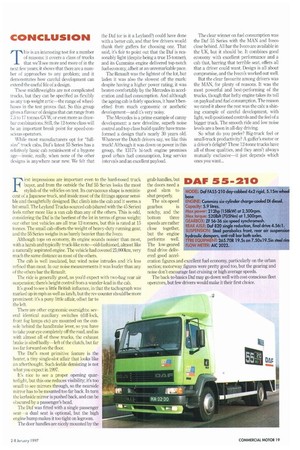CONCLUSION
Page 21

If you've noticed an error in this article please click here to report it so we can fix it.
This is an interesting test for a number of reasons: it covers a class of trucks that we'll see more and more of in the next few years; it shows that there are a number of approaches to any problem; and it demonstrates how careful development can extend the useful life of a design.
These middleweights are not complicated trucks, but they can be specified as flexibly as any top-weight artic—the range of wheelbases in the test proves that. So this group gives a flavour of designs that can range from 7,5 to 17 tonnes GI/ W, or even more as drawbar combinations. Still, the 12-tonne class will be an important break point for speed-conscious operators.
While most manufacturers opt for "fullsize" truck cabs, Dais latest 55 Series has a relatively basic cab reminiscent of a bygone age—ironic, really, when none of the other designs is anywhere near new. We felt that
the Daf (or is it a Leyland?) could have done with a better cab, and that few drivers would thank their gaffers for choosing one. That said, it's fair to point out that the Daf is reasonably light (despite being a true 15-tonner), and its Cummins engine delivered top-notch fuel economy, albeit at an unremarkable pace.
The Renault was the lightest of the lot, but laden it was also the slowest off the mark: despite having a higher power rating, it was beaten comfortably by the Mercedes in acceleration and fuel consumption. And although the ageing cab is fairly spacious, it hasn't benefited from much ergonomic or aesthetic development—and it's very noisy.
The Mercedes is a prime example of canny development: a new driveline, superb noise control and top-class build quality have transformed a design that's nearly 30 years old. Whatever the Dutch drivers say, we like this truck! Although it was down on power in this group, the 1317's hi-tech engine promises good urban fuel consumption, long service intervals and an excellent payload.
The clear winner on fuel consumption was the Daf 55 Series with the MAN and Iveco close behind, All bar the Iveco are available in the UK, but it should be. It combines good economy with excellent performance and a cab that, barring that terrible seat, offers all that a driver could want. Design is all about compromise, and the Ivec,o's worked out well.
But the clear favourite among drivers was the MAN, for plenty of reasons. It was the most powerful and best-performing of the trucks, though that hefty engine takes its toll on payload and fuel consumption. The reason we rated it above the rest was the cab: a shining example of careful development, with light, well-positioned controls and the feel of a bigger truck. The smooth ride and low noise levels are a boon in all-day driving.
So what do you prefer? Big-truck feel or small-truck productivity? A gaffer's motor or a driver's delight? These 12-tonne trucks have all of those qualities, and they aren't always mutually exclusive—it just depends which ones you want...
















































































